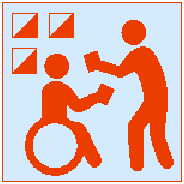
7.1 General

Trail orienteering requires map and terrain interpretation by competitors on tracks, paths and marked routes (referred to as 'trails'). Competitors are not permitted to enter the terrain off the trails and this has a number of consequences for trail-O mapping.
The competition area is that adjacent to the trails, generally within 50 m. Concentrating on this greatly reduced area, compared with foot orienteering, leads to a more detailed terrain representation and an enlarged map scale.
The map must fairly represent the terrain as seen from the trails. Features which cannot be seen may be omitted, particularly if their inclusion would distort the representation of visible features.
The concept of runnability cannot apply to trail orienteering. Those symbols and descriptions in foot orienteering which refer to passability and runnability of terrain features off the trails are amended to refer to appearance and visibility.
Trail orienteering provides competition for disabled entrants. There is a need to represent on the map stepped sections of the trails which present difficulties to competitors with impaired mobility. Special symbols are introduced for this purpose.











